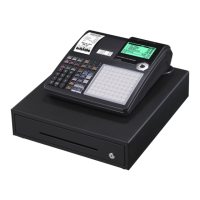

Do you have a question about the Casio SE-C3500 and is the answer not in the manual?
| Type | Electronic Cash Register |
|---|---|
| Number of Departments | 72 |
| Number of PLUs | 3000 |
| Printer Type | Thermal |
| Connectivity | USB, RS-232 |
| Power Supply | AC 120V |
| Keyboard | Raised Keyboard |
| Display Lines | 2 |
| Paper Width | 58 mm |
| Departments | 72 |
| PLUs | 3000 |
| Printing Method | Thermal |
| Display | LCD |
| Printing Speed | 14 lines/second |
| Battery Backup | Yes |
| Dimensions | 400 x 450 x 220 mm |
Instructions for returning the product to the store.
Guidance on where to place the cash register for optimal use.
Information on the required voltage and avoiding overload.
Instructions for cleaning the cash register exterior safely.
Mentions SD and SDHC Logos as trademarks.
Explains danger, warning, caution symbols and their meanings.
Provides critical safety guidelines for handling the cash register.
Details on using correct outlets and plug insertion.
Guidelines on avoiding damage to the power cord and plug.
Advises on avoiding humidity, dust, and extreme temperatures.
Precautions for managing the power cord to prevent damage.
Instructions on using, handling, and disposing of batteries.
Explains how to open the cash drawer, including manual release.
Guide to initial setup and readiness for operation.
Overview of the cash register's components and displays.
Explanation of transaction and journal receipt formats.
General procedure for daily operation before, during, and after store hours.
Procedures for categorizing and registering items by department.
Steps for programming essential register settings and data.
Covers additional registration functions like discounts and corrections.
Instructions for printing daily sales summaries.
Details on installing batteries to protect memory during power failures.
Step-by-step guide for loading receipt paper rolls.
Specific instructions for loading the journal paper roll.
Procedure for configuring date, time, and tax rates.
Specific steps to program the cash register for Australian GST.
Identifies main parts and their functions, including the mode switch.
Explains the different modes (PGM, RF, OFF, REG, X, Z, X2/Z2) and their uses.
Details on mode keys, drawer locking, and magnetic plate.
Instructions for adjusting the main and customer displays.
Guide to replacing the menu sheet for item reference.
Explains the content shown on the main and customer displays during transactions.
Identifies keys and their primary functions for operation.
Continues the explanation of various keyboard keys and their uses.
Lists and describes functions that can be assigned to keyboard keys.
Provides further details on specific function keys and their operations.
Explains how to interpret receipt and journal samples.
Steps to perform before opening the store for daily operations.
Procedures for operating while the store is open and after closing.
Steps for verifying register settings and preparing cash for transactions.
How to register a single item sale with and without change calculation.
Methods for registering multiple items of the same price or using multiplication.
Registering split package sales and changing department assignments.
How to register items using department numbers directly.
Guide to entering PGM mode and accessing basic programming menus.
Lists main programming categories like DEPT, PLU, Key, Date, and Clerk settings.
Covers Message, POP, Tax, General, SD card, and System settings.
How to program unit price, taxable status, and group for departments.
Examples of using preset prices and tax statuses for departments.
How to program unit price, taxable status, and group for PLUs.
Examples of single item sales and repeat PLU registrations.
Using multiplication key for PLU entries and split sales.
How to program and use PLUs that allow manual price entry.
How to apply discounts to items and the subtotal amount.
How to subtract amounts from item prices or subtotals.
How to register transactions paid by check or charge.
How to handle credit sales and combine payment methods.
Steps for handling customer returns while in REG mode.
Procedures for processing refunds using the RF mode.
Operations for handling money without sales, like float preparation.
Methods for fixing errors in unit price, quantity, PLU, or tendered amounts.
How to correct items or transactions right after they are registered.
How to void a single item or cancel an entire transaction.
Steps to generate and print daily sales reports using X or Z modes.
Detailed breakdown of information found in a daily sales report.
Continues the explanation of the daily sales report content.
Covers clerk assignment and single item sales setup.
How to program descriptions, messages, and names using keyboards.
Details on programming set codes, functions, and reports.
Methods for programming departments, PLUs, transaction keys, and clerk functions.
How to print configured settings and data from the register.
Options for printing various types of sales reports.
Procedures for managing data using an SD card.
Information on error codes and operational problems.
Steps to activate and set up clerk assignment for receipts.
How to sign clerks on/off and their impact on receipts and reports.
How to configure and use single item sale status for departments.
Using multiplication with single item sales.
How to register items using coupons.
How to add premiums to items or subtotals.
Forcing VAT breakdown printing at the finalization stage.
Prohibits item registration for customers below a set age limit.
How to open a new check and register items against it.
Adding items to held checks and printing guest checks.
Procedures for closing held checks and adding multiple checks together.
Using Flat PLU keys and recalling stored text.
How to record and print customer numbers.
Explains two procedures for clerk interruption during transactions.
Programming PLUs for condiments or preparations linked to main PLUs.
Programming set menus and registering customer tips.
Using the Arrangement key for automatic operation sequences.
How to add specific amounts to transactions using the Addition key.
Registering items in local currency and transacting in Euro.
Registering items in Euro and transacting in local currency.
Explains how to input characters using the dedicated keyboard.
Guide to inputting characters by repeatedly pressing ten-key pad buttons.
Further details on character input using the ten-key pad.
How to set names for PLUs, departments, and clerks.
Customizing messages that appear on receipts.
How to set graphical elements or illustrations for receipts.
Customizing symbols/titles in sales reports (e.g., 'CASH IN DRW').
Table listing memory numbers, program codes, and default characters for sales reports.
Customization for other symbols and sales report titles.
Configuration of unit number, reset options, tax systems, and print controls.
Settings for sales report printing, grand totals, and guest receipts.
Options for messages, entry restrictions, check tracking, and SD card functions.
How to set machine number and consecutive number reset options.
Configuring tax systems and rounding methods for different countries.
Options for receipt printing, including total lines and item skipping.
Controls for calculation methods, key buffer, and tone settings.
Fixed total print control for various sales data elements.
Controls for taxable amount printing and currency exchange settings.
Settings for sales report printing methods and grand total printing.
Controls for date/time printing, guest receipts, and double height characters.
Message printing, entry restrictions, and check tracking settings.
Clerk operations, Euro main currency, and rounding options.
Euro sub-currency settings and rounding.
Thermal printer control and backlight settings.
Setting multiple department or flat PLU functions at once.
Reference table for department and PLU lump programming.
How to program individual functions for each PLU.
Setting individual functions for departments using set codes.
Reference table for department and PLU programming set codes.
Setting individual functions for PLUs using set codes.
How to program specific functions onto transaction keys.
Program codes for F, Charge, and Check keys.
Program codes for RA, PO, Addition, and Coupon keys.
Program codes for P, #/NS, and o keys.
Program codes for Age Verification, Currency Exchange, Arrangement, and Text Recall keys.
Program codes for Multiplication, Tax Shift, and Credit keys.
Program code for the New Balance key.
How to set clerk interruption and secret numbers.
Settings for training mode and commission rates for clerks.
How to program set menu numbers and their items.
Setting up automatic operations using the Arrangement key.
Guide to assigning various functions to keyboard keys.
A list of function codes and their corresponding operations.
How to print programmed unit prices or percentages for items.
How to print programmed characters for departments, groups, etc.
How to print general programming settings, excluding PLUs.
How to print the preset unit prices for PLUs.
How to print preset PLU characters and PLU programming details.
How to print the current keyboard function assignments.
How to select and print various sales reports like electronic journals.
Format and content of PLU, item group, and hourly sales reports.
Format and content of monthly and flash sales reports.
Format and content of open check and electronic journal reports.
How to print reports for specific departments, PLUs, or Flat PLUs.
How to obtain periodic sales reports (weekly, monthly).
Detailed breakdown of information in periodic sales reports.
Further details on periodic sales report content.
Steps to format an SD card for first-time use.
How to back up program data from the register to an SD card.
Confirmation message after successfully backing up data to an SD card.
List of error codes, messages, meanings, and actions.
Additional error codes and their resolutions.
Handling 'EJ FULL' messages, power failures, and register lock-ups.
Explains the low battery indicator and its implications.
Detailed list of the cash register's technical specifications and capabilities.